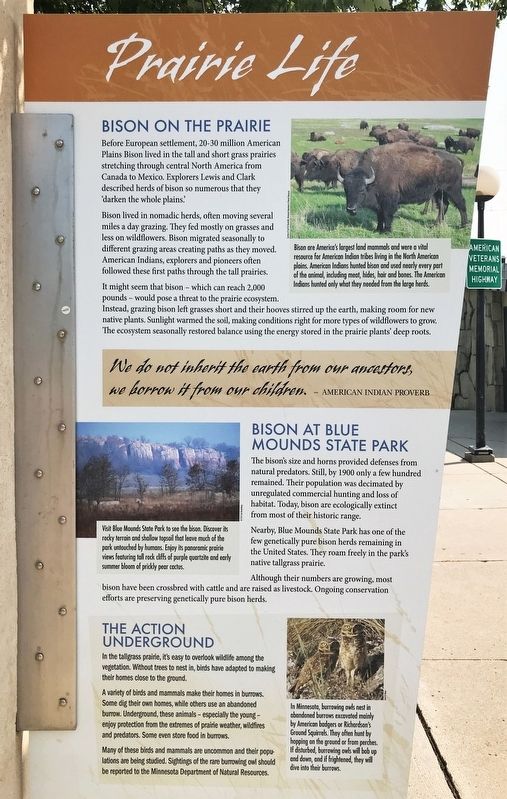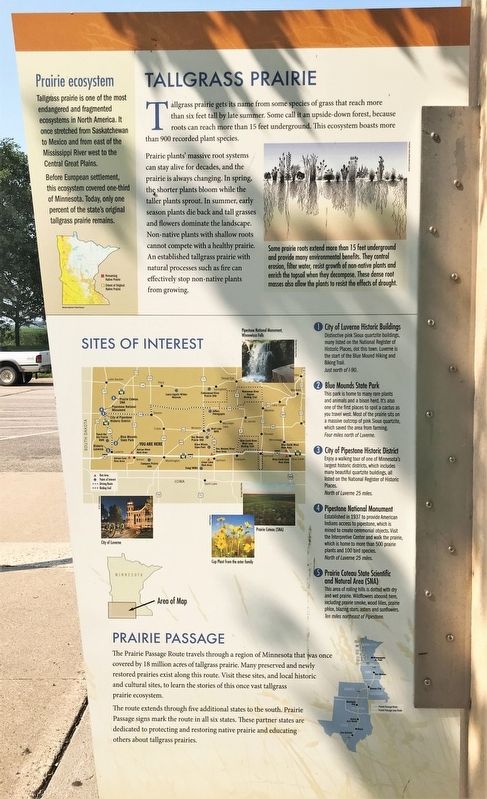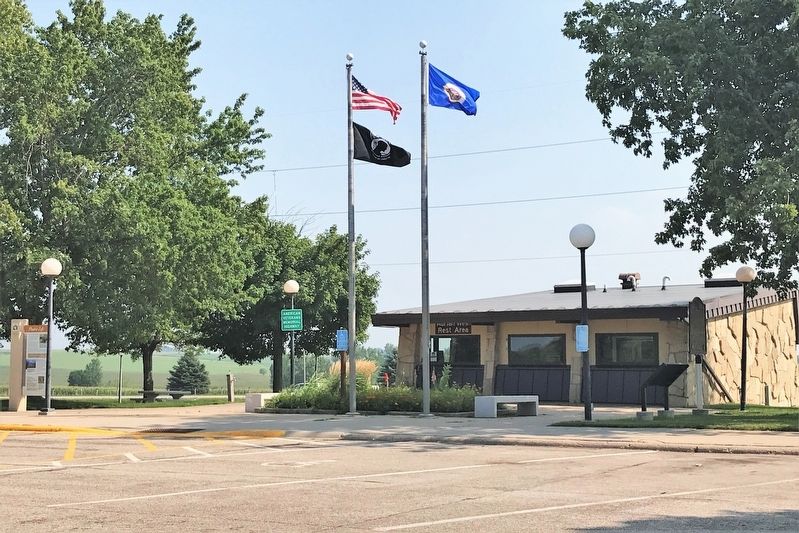Near Adrian in Nobles County, Minnesota — The American Midwest (Upper Plains)
Prairie Life
Before European settlement, 20-30 million American Plains Bison lived in the tall and short grass prairies stretching through central North America from Canada to Mexico. Explorers Lewis and Clark described herds of bison so numerous that they 'darken the whole plains.'
Bison lived in nomadic herds, often moving several miles a day grazing. They fed mostly on grasses and less on wildflowers. Bison migrated seasonally to different grazing areas creating paths as they moved. American Indians, explorers and pioneers often followed these first paths through the tall prairies.
It might seem that bison – which can reach 2,000 pounds – would pose a threat to the prairie ecosystem. Instead, grazing bison left grasses short and their hooves stirred up the earth, making room for new native plants. Sunlight warmed the soil, making conditions right for more types of wildflowers to grow. The ecosystem seasonally restored balance using the energy stored in the prairie plants' deep roots.
Caption:
Bison are America's largest land mammals and were a vital resource for American Indian tribes living in the North American plains. American Indians hunted bison and used nearly every part of the animal, including meat, hides, hair and bones. The American Indians hunted only what they needed from the large herds.
We do not inherit the earth from our ancestors, we borrow it from our children. ~ American Indian Proverb
Bison at Blue Mounds State Park
The bison's size and horns provided defenses from natural predators. Still, by 1900 only a few hundred remained. Their population was decimated by unregulated commercial hunting and loss of habitat. Today, bison are ecologically extinct from most of their historic range.
Nearby, Blue Mounds State Park has one of the few genetically pure bison herds remaining in the United States. They roam freely in the park's native tallgrass prairie.
Although their numbers are growing, most bison have been crossbred with cattle and are raised as livestock. Ongoing conservation efforts are preserving genetically pure bison herds.
Caption:
Visit Blue Mounds State Park to see the bison. Discover its rocky terrain and shallow topsoil that leave much of the park untouched by humans. Enjoy its panoramic prairie view featuring tall rock cliffs of purple quartzite and early summer bloom of prickly pear cactus.
The Action Underground
In the tallgrass prairie, it's easy to overlook wildlife among the vegetation. Without trees to nest in, birds have adapted to making their homes close to the ground.
A variety of birds and mammals make their homes in burrows. Some dig their own homes, while others use an abandoned burrow. Underground, these animals – especially the young – enjoy protection from the extremes of prairie weather, wildfires and predators. Some even store food in burrows.
Many of these birds and mammals are uncommon and their populations are being studied. Sightings of the rare burrowing owl should be reported to the Minnesota Department of Natural Resources.
Caption:
In Minnesota, burrowing owls nest in abandoned burrows excavated mainly by American badgers or Richardson's Ground Squirrels. They often hunt by hopping on the ground or from perches. If disturbed, burrowing owls will bob up and down, and if frightened, they will dive into their burrows.
Tallgrass Prairie
Tallgrass prairie gets its name from some species of grass that reach more than six feet tall by late summer. Some call it an upside-down forest, because roots can reach more than 15 feet underground. This ecosystem boasts more than 900 recorded plant species.
Prairie plants' massive root systems can stay alive for decades, and the prairie is always changing. In spring, the shorter plants bloom while the taller plants sprout. In summer, early season plants die back and tall grasses and flowers dominate the landscape. Non-native plants with shallow roots cannot compete with a healthy prairie. An established tallgrass prairie with natural processes such as fire can effectively stop non-native plants from growing.
Caption:
Some prairie roots extend more than 15 feet underground and provide many environmental benefits. They control erosion, filter water, resist growth of non-native plants and enrich the topsoil when they decompose. These dense root masses also allow the plants to resist the effects of drought.
Prairie ecosystem
Tallgrass prairie is one of the most endangered and fragmented ecosystems in North America. It once stretched from Saskatchewan to Mexico and from east of the Mississippi River west to the Central Great Plains.
Before European settlement, this ecosystem covered one-third of Minnesota. Today, only one percent of the state's original tallgrass prairie remains.
Sites of Interest
1 City of Luverne Historic Buildings
Distinctive pink Sioux quartzite buildings, many listed on the National Register of Historic Places, dot this town. Luverne is the start of the Blue Mound Hiking and Biking Trail.
Just north of I-90.
2 Blue Mounds State Park
This park is home to many rare plants and animals and a bison herd. It's also one of the first places to spot a cactus as you travel west. Most of the prairie sits on a massive outcrop of pink Sioux quartzite, which saved the area from farming.
Four miles north of Luverne.
3 City of Pipestone Historic District
Enjoy a walking tour of one of Minnesota's largest historic districts, which includes many beautiful quartzite buildings, all listed on the National Register of Historic Places.
North of Luverne 25 miles.
4 Pipestone National Monument
Established in 1937 to provide American Indians access to pipestone, which is mined to create ceremonial objects. Visit the Interpretive Center and walk the prairie, which is home to more than 500 prairie plants and 100 bird species.
North of Luverne 25 miles.
5 Prairie Coteau State Scientific and Natural Area (SNA)
This area of rolling hills is dotted with dry and wet prairie. Wildflowers abound here, including prairie smoke, wood lilies, prairie phlox, blazing stars, asters and sunflowers.
Ten miles northeast of Pipestone.
Prairie Passage
The Prairie Passage Route travels through a region of Minnesota that was once covered by 18 million acres of tallgrass prairie. Many preserved and newly restored prairies exist along this route. Visit these sites, and local historic and cultural sites, to learn the stories of this once vast tallgrass prairie ecosystem.
The route extends through five additional states to the south. Prairie Passage signs mark the route in all six states. These partner states are dedicated to protecting and restoring native prairie and educating others about tallgrass prairies.
Topics. This historical marker is listed in these topic lists: Animals • Environment. A significant historical year for this entry is 1900.
Location. 43° 38.291′ N, 95° 57.996′ W. Marker is near Adrian, Minnesota, in Nobles County. Marker can be reached from U.S. 90 at milepost 25,, 1.8 miles west of State Highway 91, on the right when traveling west. Located at Adrian Rest Area - Westbound. Touch for map. Marker is in this post office area: Adrian MN 56110, United States of America. Touch for directions.
Other nearby markers. At least 3 other markers are within walking distance of this marker. Military Highways (a few steps from this marker); A Sea of Grass (approx. ¾ mile away); Fire on the Prairie (approx. ¾ mile away).
Credits. This page was last revised on April 23, 2022. It was originally submitted on April 22, 2022. This page has been viewed 71 times since then and 10 times this year. Photos: 1, 2, 3. submitted on April 22, 2022.


